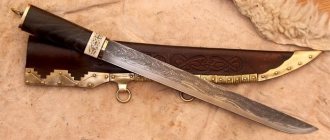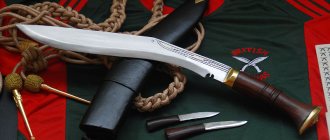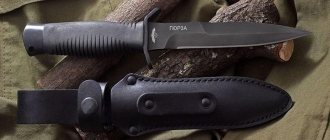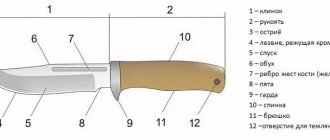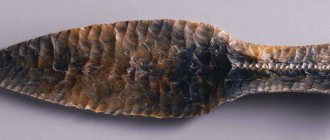The dagger is a full-fledged edged weapon worn by naval officers. It is a mandatory attribute of the uniform, awarded as a personal weapon to graduates of naval institutes, but can also be an award.
The history of the dagger dates back to the 16th century; over the centuries this type of weapon has changed, and the result is the modern dagger. It is interesting that in Russia the model used in the manufacture of weapons is the same one that was approved back in 1945. It is also considered the basis for the manufacture of daggers of other countries, adjusted for state symbols.
A short excursion into history
There are two possible origins for the name “dirk”. In the first version, it is believed that this is a derivative of the cord - a peasant knife. But according to the second version, it comes from the word “court”, which in the Netherlands meant short.
In navigation, pirates were the first to use dirks as weapons. It is quite logical that they preferred long, thin and sharp dirks to daggers and rapiers. In a ship battle, they are much more effective than any other weapon.
Another advantage was durability. Dirks withstood greater loads than thinner blades.
Gradually the length of the dagger changed and was about 80 cm towards the end of the 16th century. A little later, blades began to be popular among the general population, as well as military personnel and hunters.
In Russia, during the time of the tsars, the dirk became a mandatory attribute of naval equipment. And gradually it acquired symbolic meaning, becoming a reward type of weapon.
How and why they wear it
The main feature of this dagger, which distinguishes it from other examples of edged weapons, is the way it is worn. It is always worn on a belt with a horizontal suspension on the left side. Initially, this was explained by the need to quickly remove weapons from their scabbards in narrow holds and decks. Now it no longer serves its intended purpose, but the tradition of wearing it is strictly observed.
For a modern naval officer, a dagger is not just a bladed weapon. Graduates of naval schools receive a dagger along with their officer rank at the end of their training. For them, it becomes a symbol of male and military honor, along with shoulder straps and a reminder of their duty.
The first sea daggers description
The first dirks were a cross between a saber and a dagger. They were developed in England. Almost immediately the French also began to use them, modernizing them for their own convenience. Later they began to be divided into English and French versions. They differed in their shape:
- English - the blade was more like a saber, its feature was one-sided sharpening;
- French - in appearance it was more close to a dagger.
We can identify the common features of the most common dirks at that time. The blade was sharpened on both sides. The dagger itself was quite narrow, up to 36 cm long. Rigidity was ensured by a special groove along the entire length. It also served to drain blood. The hand was protected by a large guard.
All these characteristics made it possible to effectively use the knife for delivering any kind of blows in a confined space.
Another very interesting type of naval weapon was the boarding ax
This is a type of ax used during sailing. It was used by sailors and pirates when storming ships. Its peculiarity was a long meter-long handle secured with metal plates. It also differed from ordinary, traditional axes by the presence of a hook on the butt. This hook served as a hook. There are options with a blade instead of a hook.
These are the interesting weapons sea wolves had in the days of sailing ships.
What melee weapon do you consider the best for boarding? Write your opinion in the comments! And I invite you to our group on VK and to the ranks of the readers of our channel “Obsessed with Knives”!
Centuries-old transformations of rapiers and swords into daggers
The British were the first to notice the superiority of the shortened blade. And they deliberately began to shorten their swords and rapiers. The fashion for a small wedge quickly transferred to land combat conditions. At the beginning of the 17th century, the first products appeared with the following parameters:
- blade length – 80 cm;
- double-sided sharpening;
- sometimes a curved wedge.
The product had nothing to do with sailors. It was successfully used for stabbing and slashing. Wealthy people decorated the handle with stones.
The appearance of the prototype of the modern dirk
In the middle of the 17th century, truncated rapier blades were used when fighting in confined spaces. The cutter performed well in street battles. And only towards the end of the century did sailors become interested in blades. What is a dirk? It is a cut-down sword blade, sharpened like a dagger.
The dirk was used not only in battle, it was convenient for cutting up large pieces of meat for drying. The Dutch and British were keen on this purpose. But the combat qualities of the product were liked by naval officers.
An example of a dagger from the late 17th - early 18th centuries.
They attached high importance to the product; the loss or capture of a dagger by the enemy was equal to the loss of military honor. The junior staff tried to make a blade themselves from rapiers and swords. Making a dagger to order was not cheap.
The gunman pushes out long blades
The advent of firearms has a negative impact on the need for piercing weapons. In close combat, pistols are used; long blades of 80 cm, although already shortened, are still quite inconvenient.
In the 18th century, the view of the dagger changed; it became closer in size to modern products. Their length did not exceed 50 cm, the dagger became more compact. The lack of regulation of sailors' uniforms made it possible to carry the product with them at all times.
A new era in the history of the dirk
In the 19th century, the production of daggers began in various countries. Their purpose was already specific - for naval officers. The first thoughts about the obligatory attribute to the form appear. The blades of the products did not exceed 410 mm, the handle was covered with leather.
An example of a 19th century Bulgarian dagger. They were worn by orderlies on the battlefield.
The use of materials for making daggers differed in different countries. The guards and poms of the handle were made in the form of predatory animals and birds. There were also differences in color solutions. Only in the 20th century did dirks become official attributes of military uniforms in many countries. And they began to look more strict.
Unified standard for officers' daggers
For a long time there were no uniform standards for the manufacture of officer daggers. They were very different: the length, shape of the handle and guard. Starting from the 17th century, common features began to appear in weapons workshops - a transverse shape and, of course, the presence of a guard.
Already closer to the 19th century, specific dimensions appeared, the length of the blade was at least 300 mm and the handle was made of ivory. In 1913, they decided to spare the elephants. Handles began to be made of wood or metal and covered with natural leather.
The length of the blade was also reduced to 240 mm. In Soviet times, no standards were developed for officers' daggers. The parameters adopted in 1945 are valid to this day.
The dagger is a distinctive feature of the highest ranks
In the days of one-eyed pirates and robbers with a bony image on a black flag. The sailors noticed that it was convenient to use a naval dirk to fight off opponents. Using the product as a weapon did not limit its capabilities. He showed himself worthy for economic and domestic needs.
In the wild, left without food, the dagger was successfully used as a hunting knife. Cutting a rope or rope did not cause any problems either. When firearms appeared, battles often did not reach hand-to-hand combat. Cannons, pistols and muskets were more effective.
Air Force dirk, model 1957, made at the ZIK factory.
The naval dirk was losing its relevance. But they were in no hurry to abandon it completely. And the dagger became a beautiful attribute of the officers. By the presence of the product on a person, it became clear that in front of you was a difficult person.
How the dagger became an officer's dagger
The dagger was not always an officer's weapon; at first it was used by ordinary sailors and fought off enemies when the ship was boarded and captured. But over time, officers noticed that such a “knife” is very convenient for fighting, it can be used for any other needs, including household ones - for example, quickly cutting a rope/cable, hunting under force majeure circumstances to provide food.
The dagger became a truly officer's attribute only in the middle of the 19th century, when lower ranks and ordinary sailors simply no longer needed this weapon - artillery successfully coped with battles, firearms were convenient in close/long-range combat. It was during this period that the dirk became the “identification” sign of senior officer ranks in the navy.
German naval dagger
The first daggers began to appear in Germany already in the 20th century. For their weapons, they borrowed the shape of Russian blades. Officially, the dagger became a weapon for officers in 1919. Its length was 34 cm, of which the blade accounted for 23 cm.
The German military loved to decorate their weapons with images related to the sea. Gradually, the blades changed a little and began to differ from Russian ones. They had well-defined ribs on the blade. And the handle ended in a small ball.
SS dirk, model 1933, the inscription reads: “My honor is called fidelity.”
The Nazis made their contribution to the appearance of the weapon. Already in 1938, the SS dagger became longer and was 35 cm. A swastika was depicted on the top of the handle, and the guard was made in the form of an eagle with folded wings and a swastika in the claws.
Pricing Features
Due to the fact that daggers were produced quite centrally, their cost depends on a small number of factors:
- Rarity are daggers that were produced for small armed units (for example, the special squad “Alpha” and “Vympel” of the KGB of the USSR).
- Finish - The scabbard may have been gilded (earlier models), and the handle is made of white ivory plastic.
- The condition of the dirk and the year of manufacture - older and well-preserved specimens are more expensive.
- The material from which the sword belt is made could be a simple fabric base, or it could be made of expensive types of leather.
The blade itself was made of ordinary stainless steel - the only exceptions could be general's samples.
Russian naval dagger
Peter the Great was the first to bring naval daggers to Russia, returning from a trip to Europe. One of the emperor's blades, which was once kept in a museum in Budapest, was 63 cm long, but in the hands of the Russian Tsar, known for his large size, it looked like just a small knife. Its wooden scabbard, covered with leather, was decorated with symbols of Russia's victory over Sweden.
Peter the Great introduced the dagger as the standard weapon of Russian sailors. Unlike other innovations of the emperor, such as shaving the beard, this particular innovation immediately received a very warm welcome and became a firmly ingrained tradition.
After the death of Peter the Great, the Russian navy entered a miserable period of ten years of decline, and the dirk at that time began to be considered an ordinary weapon that could be used by anyone: naval and military officers, administrative officials, etc. In 1777, it was transferred to non-commissioned officers -officers of regiments of rangers instead of swords, and these knives could be placed in carbines and used as bayonets.
Starting from the end of the 18th century, the dagger was no longer used as a boarding weapon. There were several reasons for this. First of all, by that time it had already been completely replaced by a more effective saber. Secondly, with the rapidly and steadily developing artillery, naval battles rarely ended in the capture of enemy ships - it was now faster and more convenient to smash them to pieces and then sink them. Since then, the naval dagger has become a personal edged weapon and has become accepted by everyone as part of the uniform.
The Russian dagger of 1803 had a double-edged blade 30 cm long, and, amazingly, its handle was supposed to be made only of ivory! It was intended to emphasize the high social status of its owner. Currently, such dirks cost from 10 to 100 thousand US dollars.
The price of a dagger was often too high even for the nobility, and that is why daggers were valued and passed down from generation to generation, which, of course, created a special aura of holiness around this weapon.
Obviously, this was the time when most of the traditions regarding sea knives arose in the Russian Navy. The sailors were so proud that they had the right to wear daggers that they did not want to give up this monopoly.
As noted above, over time the length of the blades gradually decreased, from 1913 their length became up to 240 mm, and it was also possible to use cheaper materials instead of ivory.
Classification of dirks in Russia
Already in the 20th century, the dagger became a permanent attribute of the dress uniform of most countries. In Russia they have two main purposes. They can be classified into two types:
- Named weapon. Such a product is awarded to honorary citizens who have made a huge contribution to the development of the country or have done something outstanding for Russia. In rare cases, a blade is given to people of another country as proof of trust and friendly relations between states.
- Personal weapon. The presentation of the blade occurs to graduates of military educational institutions in a solemn atmosphere. Constant wearing of the product is prohibited; this is dress uniform ammunition. All graduation diplomas are accompanied by daggers. The tradition includes the consecration of the product in the temple.
The tradition of preserving dirks is present in many countries. Even after the death of the owner, the state does not claim its return. This is a memory for posterity, on par: with medals, orders and uniforms.
Varieties of daggers in modern Russia
What a dagger is becomes clear from the above. The straight, thin diamond-shaped dagger was loved not only by sailors. Having survived many modifications, today it is an element of the dress uniform of the Navy, Air Force and Ground Forces.
In Russia, six varieties of daggers with individual parameters and characteristics are produced. Blade size, handle length and material, steel grade, scabbard decoration. Let's consider each option separately:
- Officer. The total length of the product is 490 mm, 345 mm is given to the blade. The scabbard is decorated with the emblem of the type of troops to which the military belongs. Its appearance has not changed since the 19th century, the blade has gilded engraving, and the scabbard is decorated with semi-precious stones.
- Generalsky . A distinctive feature of the product is a narrow blade of 17 mm at the handle. Its length is 330 mm, and the overall dimensions of the dagger reach 440 mm. The blade is engraved with gold filigree. The scabbard is decorated with precious stones and gold elements.
- Admiral's . This product is a real work of art. All samples are original, there are no prototypes. Its total length reaches 440 mm, the blade takes 280 mm. It is engraved with gold and other precious metals. The scabbard is inlaid with precious and semi-precious stones. The most expensive product among its brothers.
- Marine . The dagger does not have precious metals and is not decorated with stones. It has a total length of 400 mm, the blade is 275 mm. It is made according to the model of an officer's dagger from 1820. The shortest product among the options under consideration.
- Award . An excellent gift for officers of the Russian special services. They are made in various variations and according to individual sketches. The dagger is engraved with: memorable dates, personal details. The dirk is available for purchase in knife stores.
- Front . This version of the product is not much different from a sea blade. Decorated a little more richly, without the use of precious metals and stones.
Nautical.
Officer.
General's.
Admiral's
There are enough modern replicas of all types of daggers in stores. Their cost is low, simple options are estimated at 5-6 thousand rubles. A worthy souvenir for a fighting friend.
Features of the Navy dagger
Marine products have always been distinguished from other daggers by their rich decoration. Elements of gold engraving were present on both the blade and the sheath. Semi-precious and precious stones were present on the knife case.
Dirks from different countries differed little in size. The main differences were:
- design solutions;
- materials used;
- decorative elements and methods of their installation.
Distinctive signs that the product belongs to a specific military unit, an integral part of the blade. In the USSR, 1945 was marked by the first dagger of the Navy. The product is stored throughout the day. Its characteristics:
- double-sided dagger sharpening;
- diamond-shaped blade;
- the handle is made of plastic;
- a special latch on the handle will not allow the blade to fall out;
- handle is barrel-shaped, tetrahedral;
- the crosspiece and pommel are made using gilding;
- wooden scabbard covered with leather and varnished;
- total length of the product – 320 mm;
- blade length – 215 mm.
The scabbard of the Russian Navy dirk is decorated with gilded clips. On the top there are images of an anchor and a sailboat. The pictures are arranged symmetrically, on different sides. The coat of arms of the USSR is minted at the top of the handle.
Weapons of other countries - borrowing a dirk
Japanese dagger
As for borrowings in the navy, the transfer of foreign experience to Russia was most often observed, this has been the custom since Peter the Great. However, daggers were copied by a number of states specifically from Russian sailors .
So, they appeared in Germany in 1902, after Kaiser Wilhelm II saw them among the crew members of the cruiser Varyag. In the 1880s, even before the Kaiser, the Japanese did the same, despite the fact that they were opponents of Russia at that time. The dagger was adopted in a slightly different form - the Japanese considered it appropriate to stylize the weapon as a short samurai sword. He appeared in their fleet in exactly this form.
Thus, it was not by chance that the dagger appeared in the navy. Since the times when ships were boarded, it was necessary to have edged weapons on hand, the use of which would not create problems in confined spaces, and this blade turned out to be the optimal solution to the problem. Today, the item remains part of the ceremonial naval uniform, the pride and main decoration of a naval officer, admiral or general, and even midshipman.
If you find an error, please select a piece of text and press Ctrl+Enter.
The first models of Soviet blades
In 1914, naval vessels were officially transferred to the USSR air forces. Apparently, this was due to the fact that aviation began to be called the air fleet. And when in 1916 the dagger became the personal weapon of senior officers, and then military doctors, the rage and indignation of the sailors crossed all boundaries.
The final blow to the prestige of the Navy was dealt by the Provisional Government, which ordered the distribution of daggers to all generals, officers and military officials, with the exception of cavalrymen and artillerymen.
However, these land dirks were smaller and did not boast the same impressive appearance as those worn by naval officers.
The dagger as an officer's attribute was abolished by the Soviet government. In 1924, an attempt was made to turn it into a weapon for naval commanders, but heated internal disputes broke out in the Communist Party between the ultra-revolutionaries and the "supporters of strong government and national ideas", which led to the defeat of the latter.
Navy dirk in disassembled condition.
Only in 1940 did the dagger return to the Soviet fleet. Along with shoulder straps, they began to present it to graduates of the Higher Naval Academies at a ceremony along with diplomas and first ranks.
After the Great Patriotic War, the dagger again decreased in size: now its total length was only 320 mm with a blade of 215 mm. Unfortunately, not a trace remains of its former splendor and glory - currently its handle is not made of ivory, as before, but of plastic of a similar color.
Conflict over the right to wear cutlass
On December 13, 1996, Russian President Boris Yeltsin signed the federal law “On Weapons,” according to which a standard officer’s dagger fell under the definition of a bladed weapon (blade length greater than 90 mm) and from which restrictions on its carrying and storage followed. According to the law, its wearing was allowed only to military personnel in full dress uniform or those discharged from military service with the right to wear a military uniform. After this, cases became more frequent when internal affairs officers began to demand permission to store them from former military personnel or their families.
In 2013, a new Guidelines for accounting for weapons, military and special equipment and other material assets in the RF Armed Forces was approved, which required that upon dismissal from military service, a dagger and other weapons should be handed over to the warehouse of a military unit using invoices. After the return of the dagger to the uniform in the fall of 2015, Minister of Defense Sergei Shoigu began to receive requests from veteran organizations asking to remove the provision on handing in daggers from the Manual. The requests were motivated by the fact that officers and midshipmen of the Navy, transferred to the reserve with the right to wear a uniform, were forced, in violation of the rules, to wear a uniform without a dagger. In addition, it was noted that a dagger for the family of an officer and midshipman is a family heirloom, and according to the Charter of the Internal Service of the Russian Federation, during the burial ritual of officers and midshipmen of the fleet, a crossed dagger and scabbard must be attached to the lid of the coffin.
The most popular Soviet blades
The most common are the blades of officers from 1945 and generals from 1940. The model, intended for awarding Soviet generals, had a number of features:
- diamond-shaped blade 33 cm long;
- handle straight, yellow;
- the back plate is steel, cylindrical, with a five-pointed star on it;
- black metal sheath.
One of the most famous award daggers is the dirk of St. Andrew the First-Called.
What models can be purchased today
In the modern world, the production of edged weapons is strictly limited. Real dirks are produced only to equip the military. Civilians can purchase commemorative daggers, the length and hardness of which do not allow them to be classified as melee weapons. In addition, they lack a guard. This makes it possible to classify them as hunting knives. However, they are extremely inconvenient to use, since historically their form was created for other purposes.
Previous
KnivesSamsonov knife for bear hunting
Next
Combat knivesBallistic knife that shoots blades
Where to buy USSR daggers?
The KnivesExpress online store offers inexpensive purchase of USSR daggers (replicas), which fully correspond to the design, size and shape of the historical originals.
Our craftsmen use the following as the main construction materials:
- for blades – alloy steel 65X13 with high resistance to corrosion, wear and scratching;
- for the sheath – dried solid wood, brass, genuine leather;
- for the handle - brass casting and impact-resistant plastic, resistant to cracking and ultraviolet radiation.

